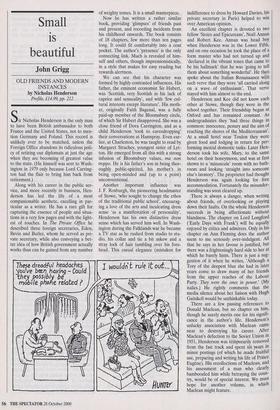Small is beautiful
John Grigg
OLD FRIENDS AND MODERN INSTANCES by Nicholas Henderson Profile, £14.99, pp. 212 Sit Nicholas Henderson is the only man to have been British ambassador to both France and the United States, not to men- tion Germany and Poland. This record is unlikely ever to be matched, unless the Foreign Office abandons its ridiculous poli- cy of retiring our diplomats at just the age when they are becoming of greatest value to the state. (He himself was sent to Wash- ington in 1979 only because Lord Caning- ton had the flair to bring him back from retirement.) Along with his career in the public ser- vice, and more recently in business, Hen- derson has led the life of a most companionable aesthete, excelling in par- ticular as a writer. He has a rare gift for capturing the essence of people and situa- tions in a very few pages and with the light- est of touches. In The Private Office he described three foreign secretaries, Eden, Bevin and Butler, whom he served as pri- vate secretary, while also conveying a bet- ter idea of how British government actually works than can be gained from any number of weighty tomes. It is a small masterpiece.
Now he has written a rather similar book, providing 'glimpses' of friends past and present, and recording incidents from his childhood onwards. The book consists of 18 chapters, few more than ten pages long. It could fit comfortably into a coat pocket. The author's 'presence' is the only connecting link. Much is revealed of him- self and others, though impressionistically, in a style that makes for easy reading but rewards alertness.
We can see that his character was formed by highly contrasted influences. His father, the eminent economist Sir Hubert, was 'Scottish, very Scottish in his lack of caprice and sensuality', and with 'few cul- tural interests except literature'. His moth- er, originally Faith Bagenal, was a fully paid-up member of the Bloomsbury circle, of which Sir Hubert disapproved. She was a close friend of Dora Carrington, and as a child Henderson 'took to eavesdropping' their conversations at Hamspray. Even ear- lier, at Charleston, he was taught to read by Margaret Strachey, youngest sister of Lyt- ton. He emerged from all this with a strong infusion of Bloomsbury values, ma non troppo. He is his father's son in being thor- oughly public-spirited, his mother's in being open-minded and (up to a point) unconventional.
Another important influence was J. F. Roxburgh, the pioneering headmaster of Stowe, 'who sought to change the ethos of the traditional public school', encourag- ing a love of the arts and inculcating dress sense 'as a manifestation of personality'. Henderson has his own distinctive dress sense which has served him well. In Wash- ington during the Falklands war he became a TV star as he rushed from studio to stu- dio, his collar and tie a bit askew and a stray lock of hair tumbling over his fore- head. This casual elegance (mistaken for indifference to dress by Howard Davies, his private secretary in Paris) helped to win over American opinion.
An excellent chapter is devoted to two fellow 'Stoics and Epicureans', Noel Annan and Robert Kee. Annan was head boy when Henderson was in the Lower Fifth, and on one occasion he took the place of a form master who had not turned up and `declared in the vibrant tones that came to be his hallmark' that he was 'going to tell them about something wonderful'. He then spoke about the Italian Renaissance with such verve that they were 'all carried along on a wave of enthusiasm'. That verve stayed with him almost to the end.
Henderson and Kee did not know each other at Stowe, though they were in the school together. Their friendship began at Oxford and has remained constant. As undergraduates they 'had three things in common: innocence, penury and the aim of reaching the shores of the Mediterranean'. At a small hotel near Toulon they were given food and lodging in return for per- forming menial domestic tasks. Later Hen- derson took his wife, Mary, to the same hotel on their honeymoon, and was at first shown to a 'minuscule' room with no bath- room and looking 'straight into someone else's lavatory'. The proprietor had thought Henderson was again looking for free accommodation. Fortunately the misunder- standing was soon cleared up.
There is always a danger, when writing about friends, of overlooking or playing down their faults. On the whole Henderson succeeds in being affectionate without blandness. The chapter on Lord Longford (Tarty Days with Frank') will be equally enjoyed by critics and admirers. Only in his chapter on Ann Fleming does the author seem to me seriously over-indulgent. All that he says in her favour is justified, but there was a frighteningly hard side to her at which he barely hints. There is just a sug- gestion of it when he writes, 'Although a Tory of the deepest blue she had in later years come to draw many of her friends from the upper reaches of the Labour Party. They were the ones in power.' (My italics.) He rightly comments that the media silence about her liaison with Hugh Gaitskell would be unthinkable today. There are a few passing references to Donald Maclean, but no chapter on him, though he surely merits one for his si cance in the author's life. Henderson's unlucky association with Maclean came near to destroying his career. After Maclean's defection to the Soviet Union In 1951, Henderson was temporarily removed from the fast track and spent six years In minor postings (of which he made fruitful use, preparing and writing his life of Prince Eugene). His recollections of Maclean, and his assessment of a man who clearly bamboozled him while betraying the coun- try, would be of special interest. We must hope for another volume, in which Maclean might feature.
1-


























































































 Previous page
Previous page